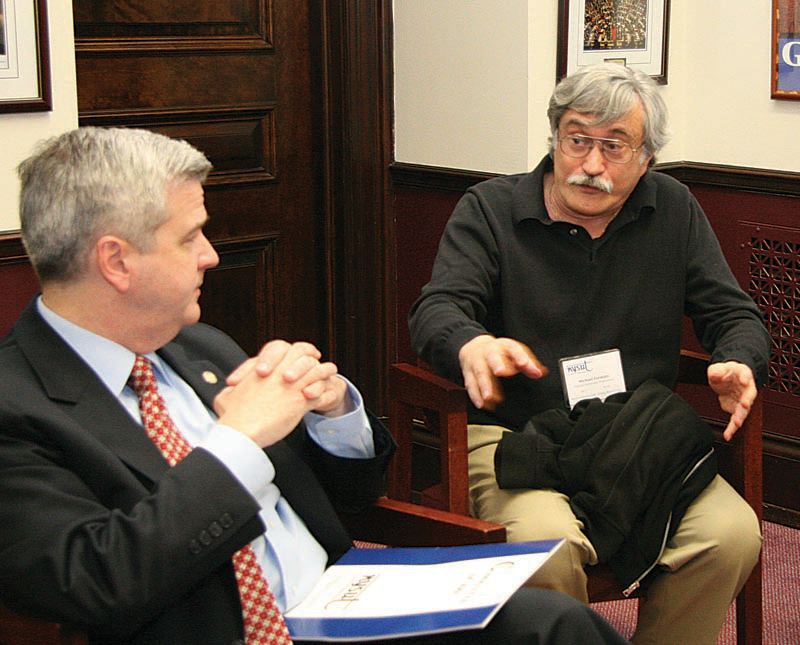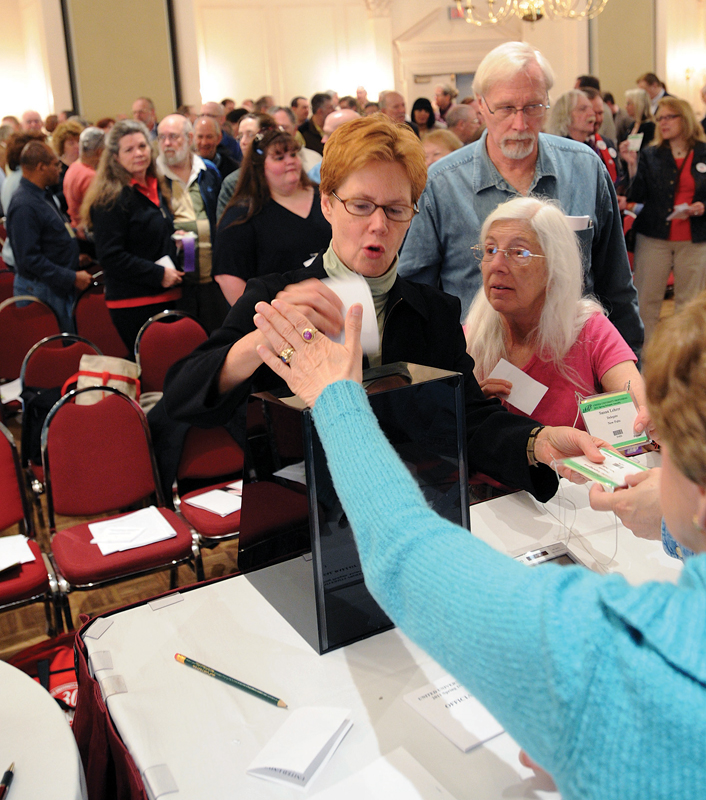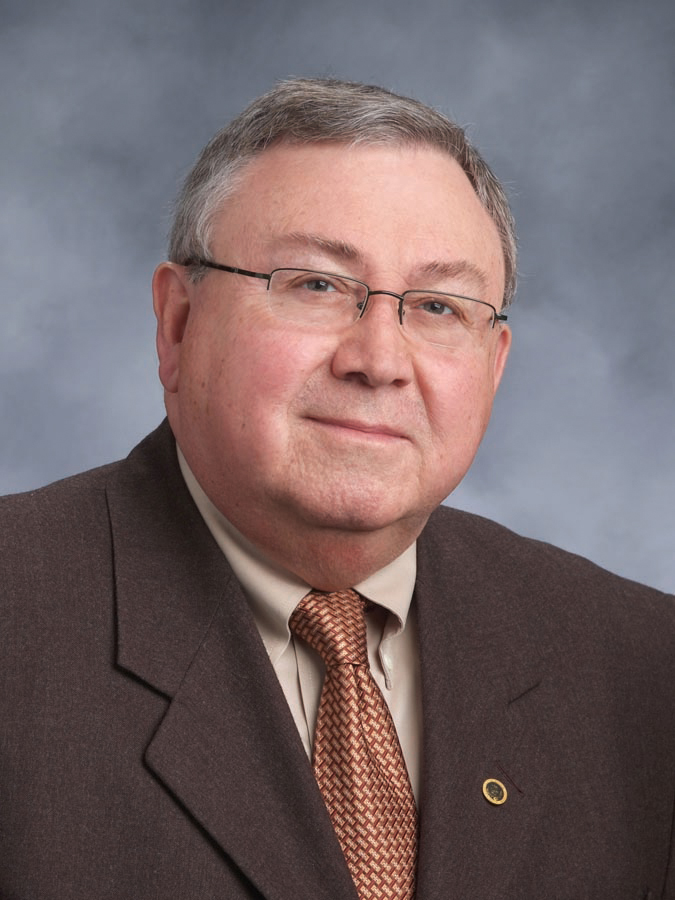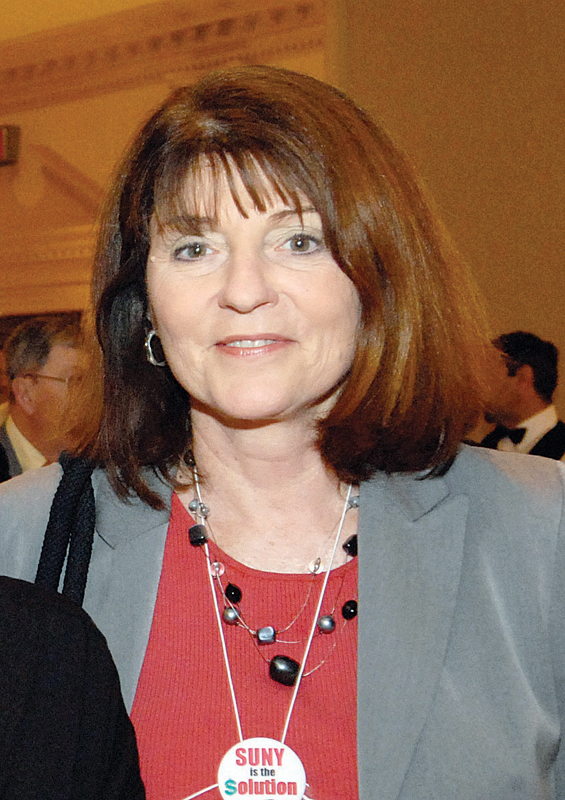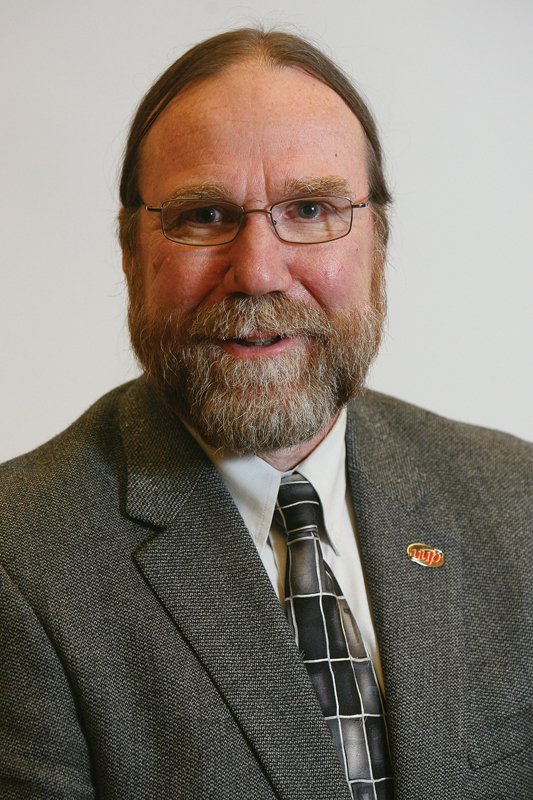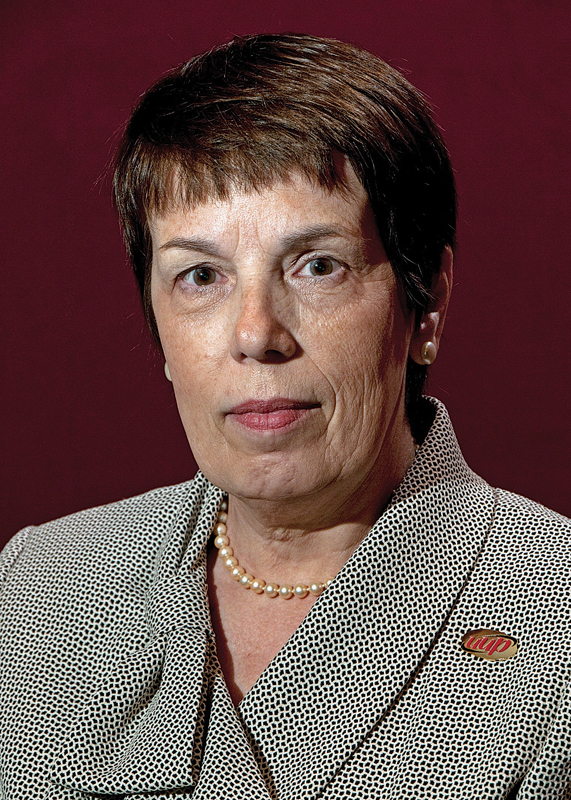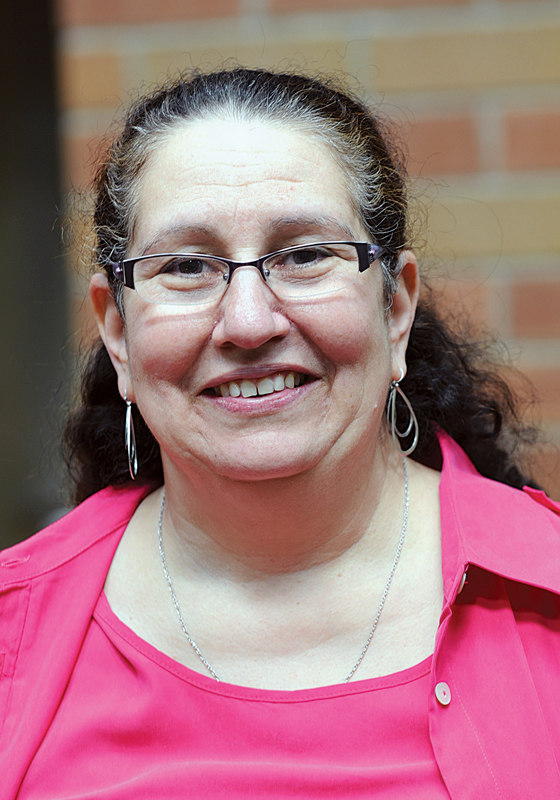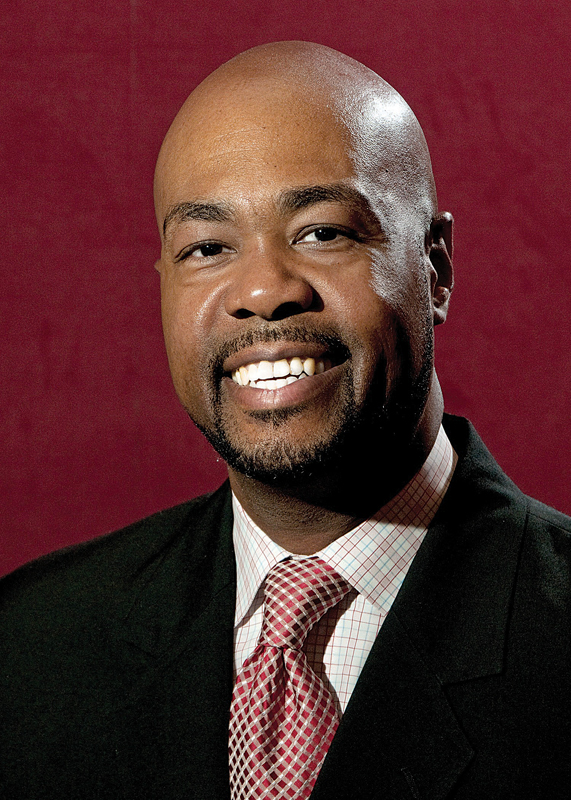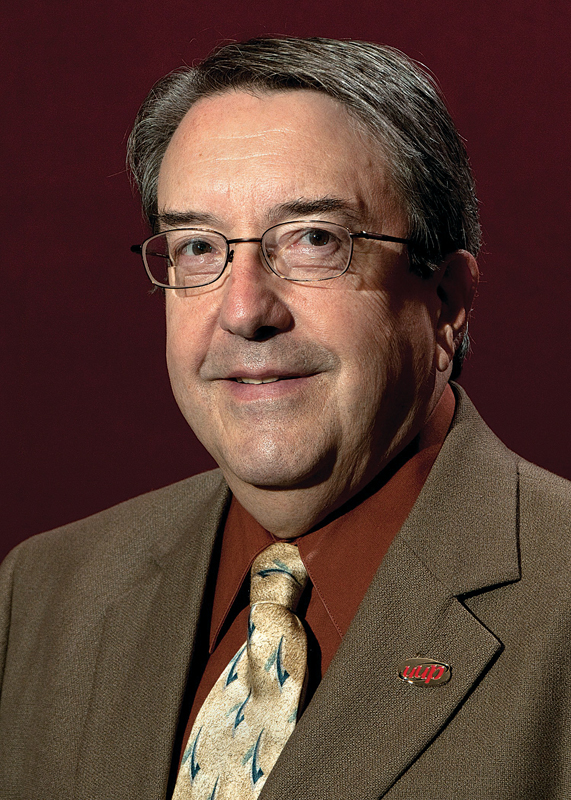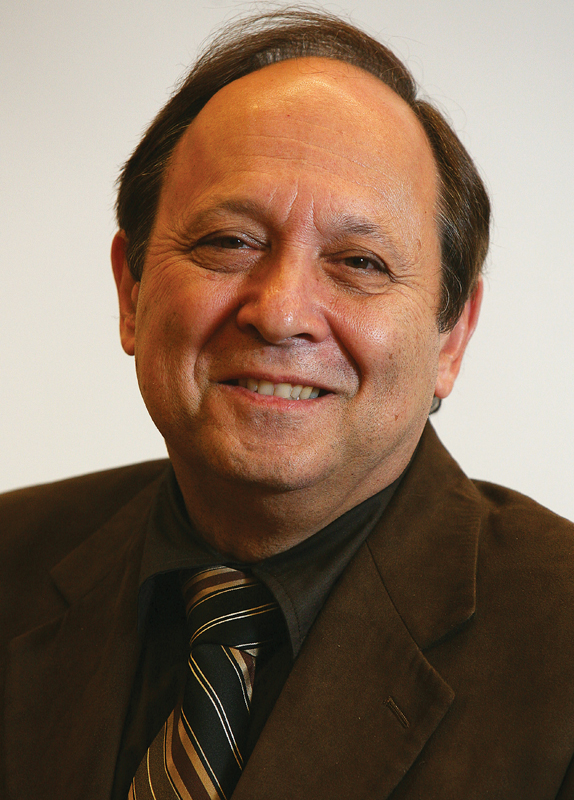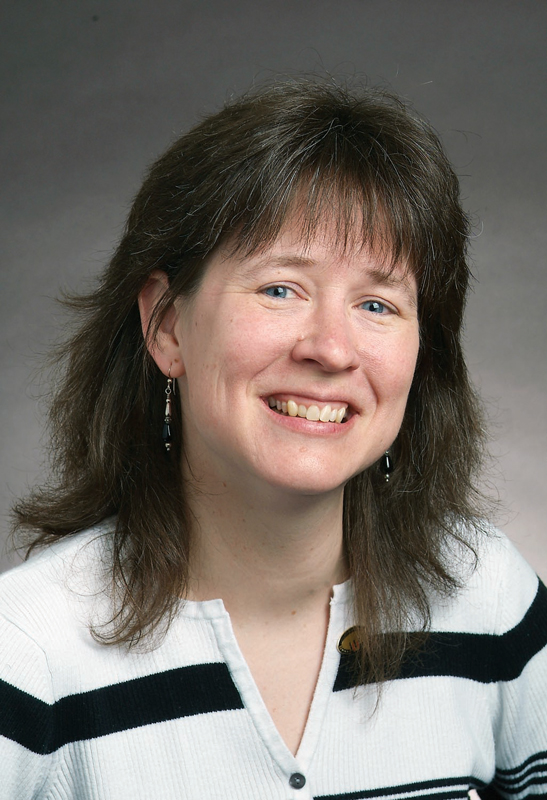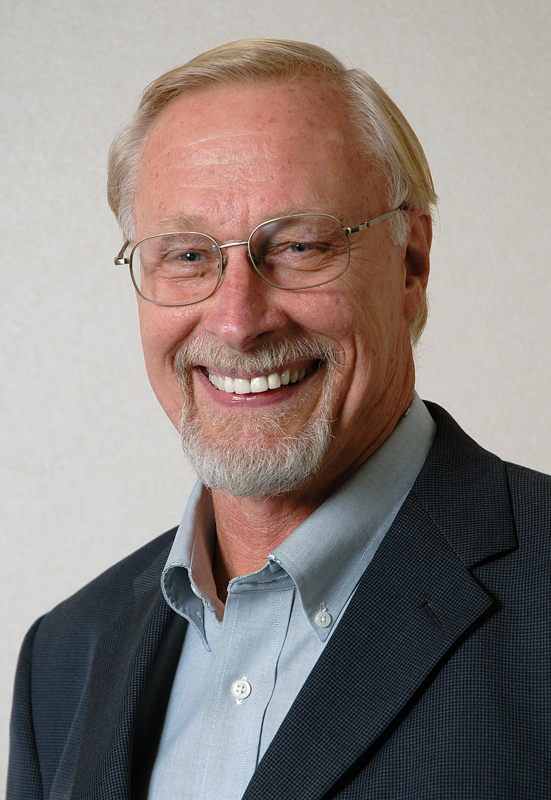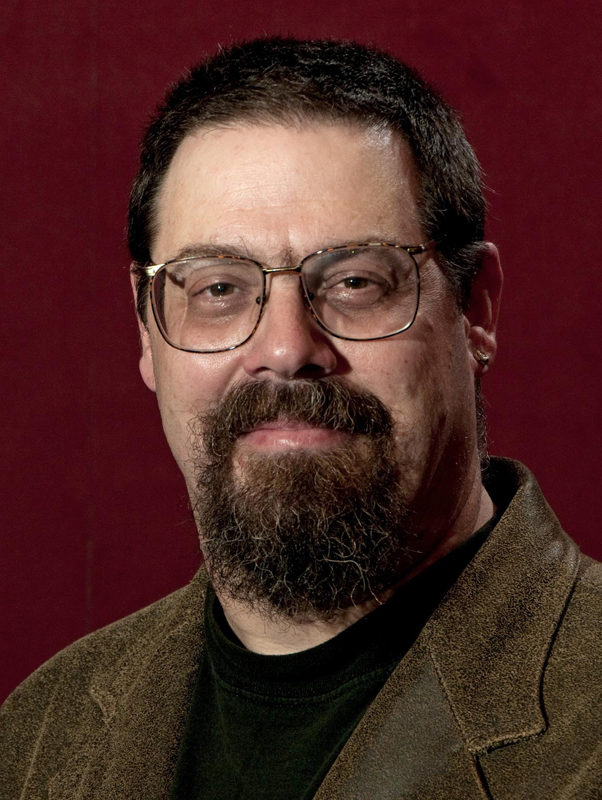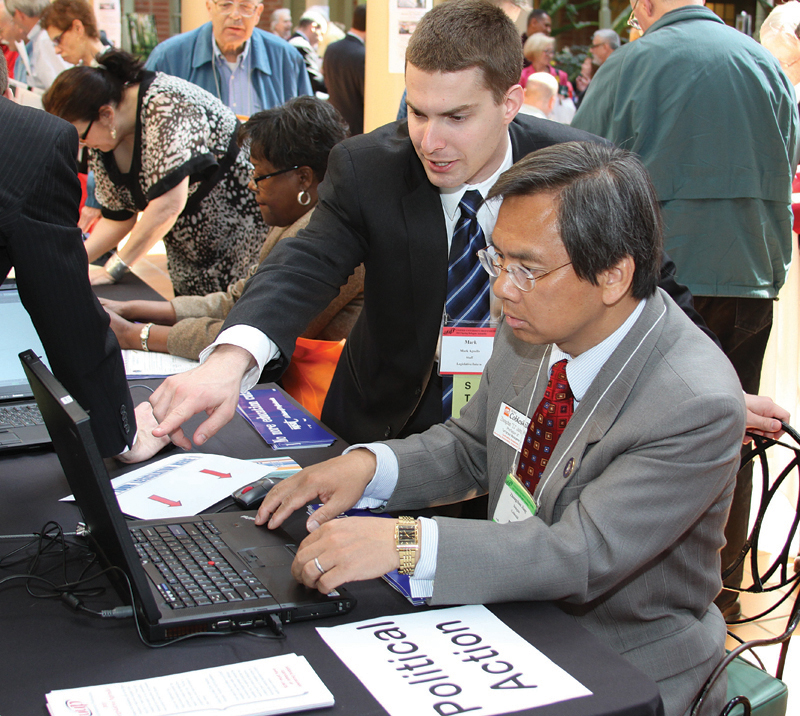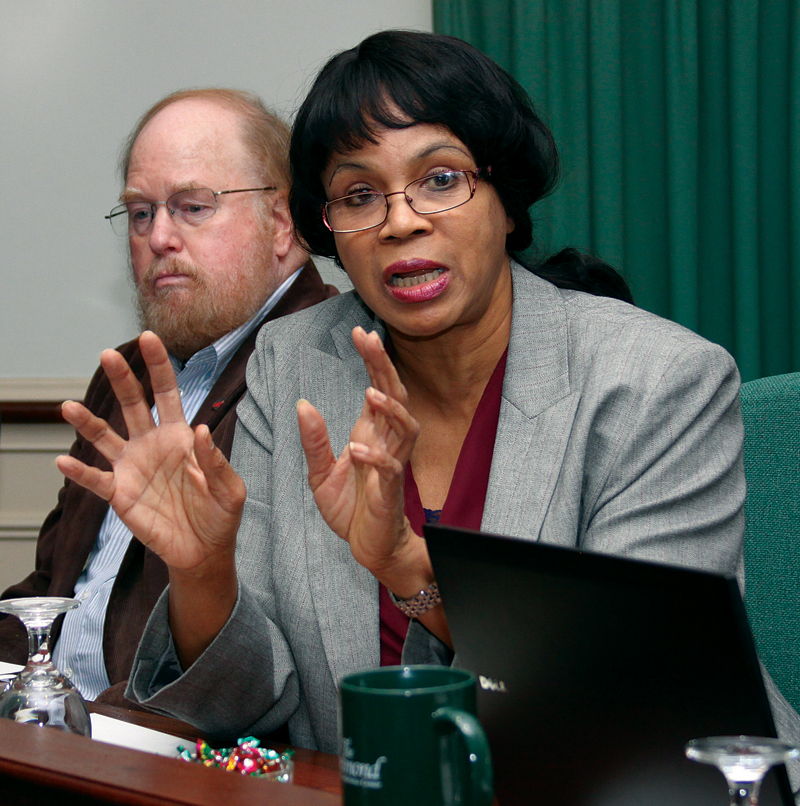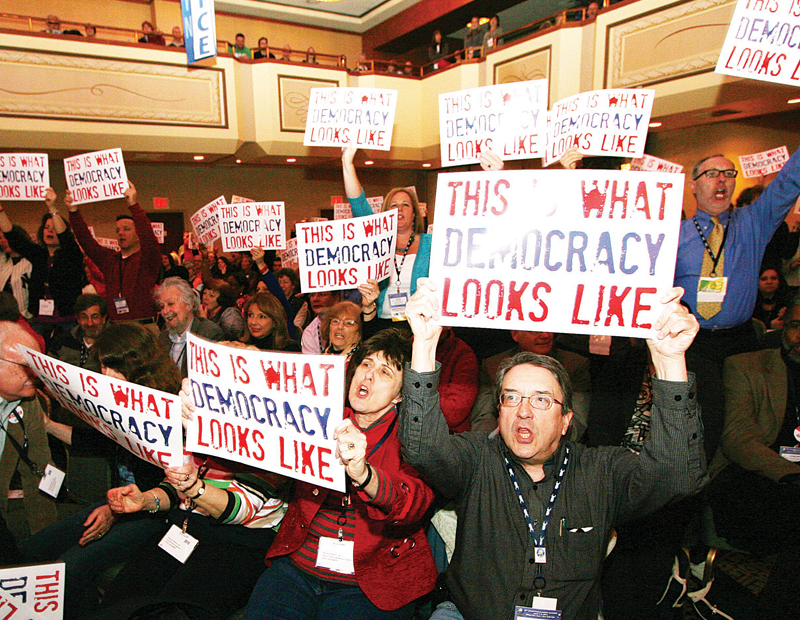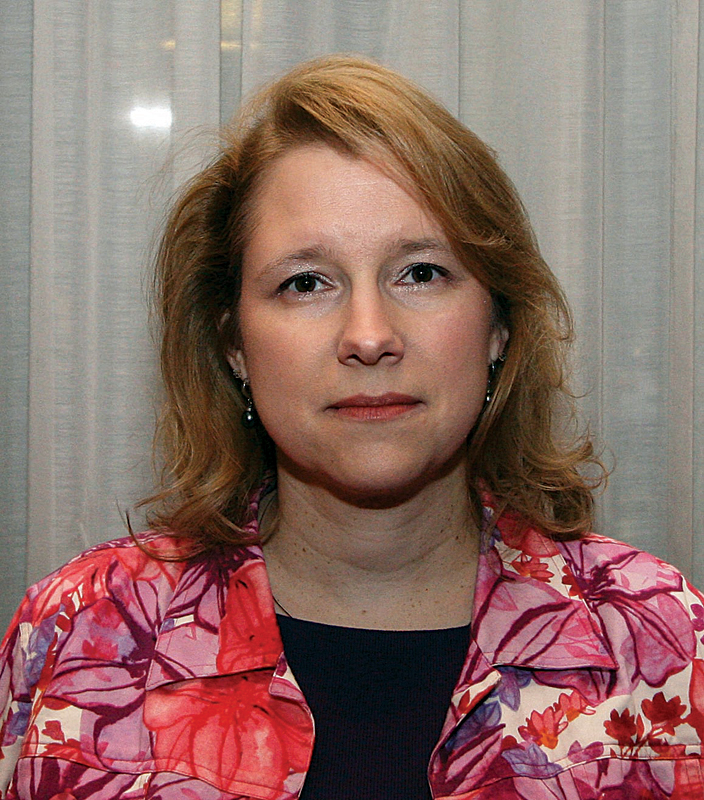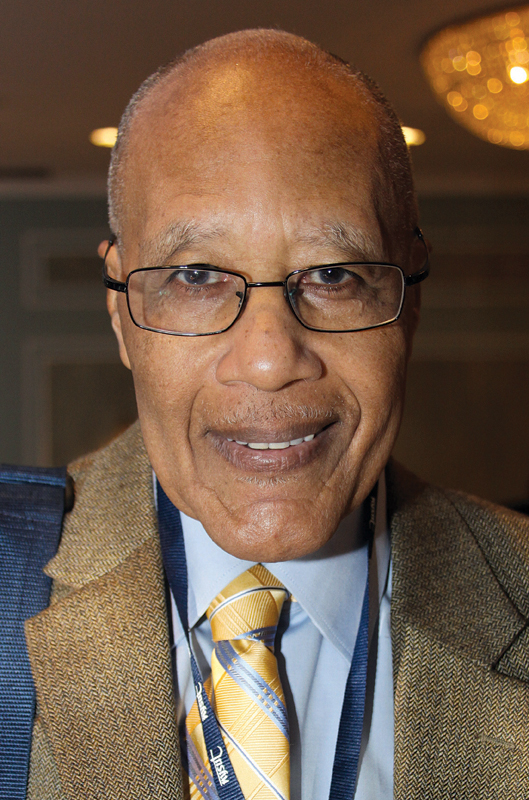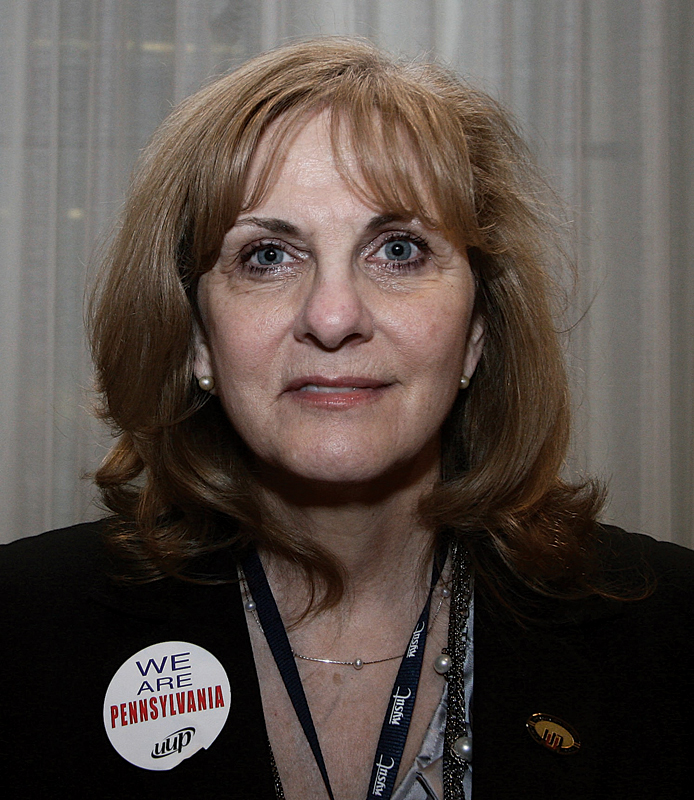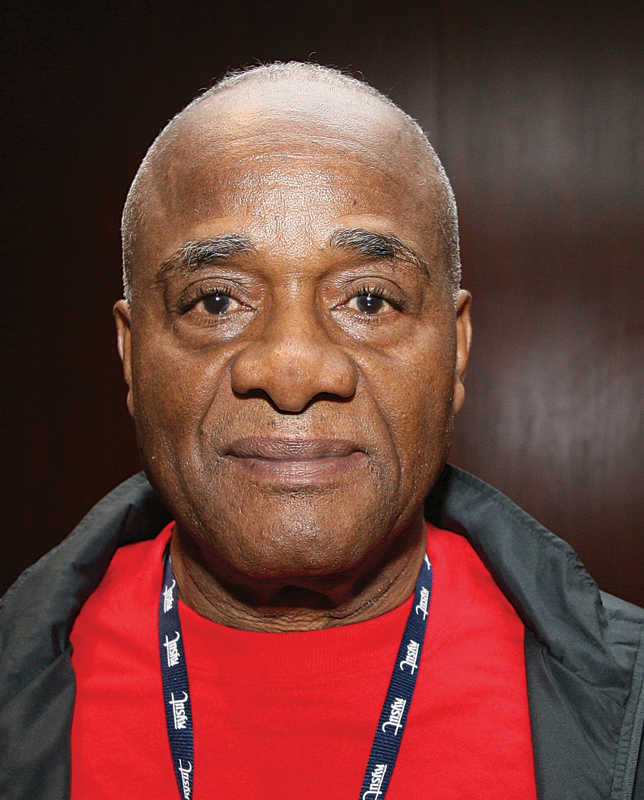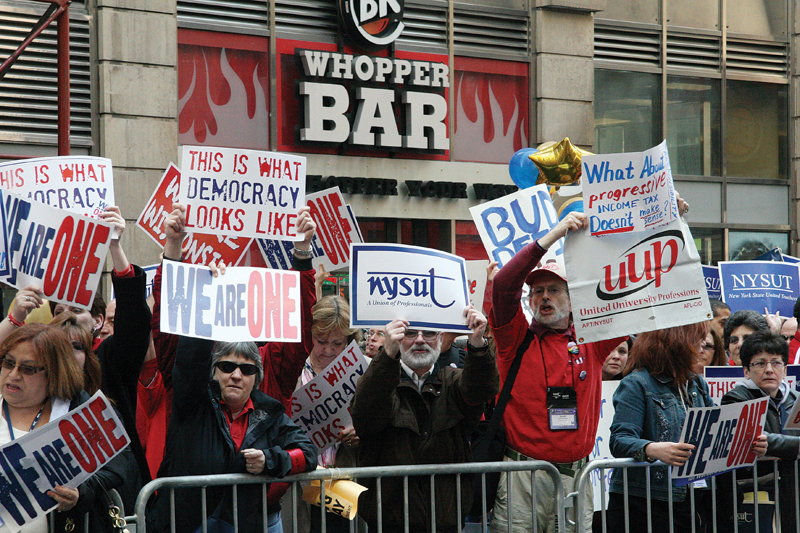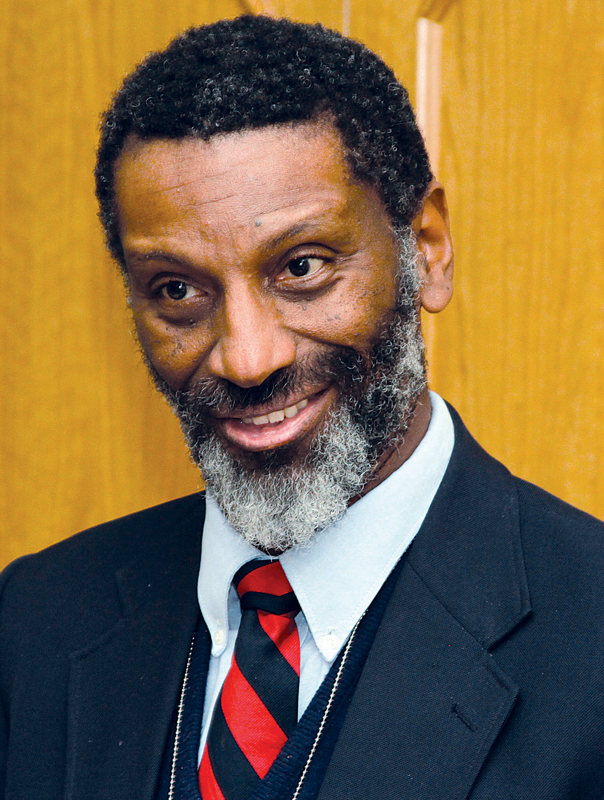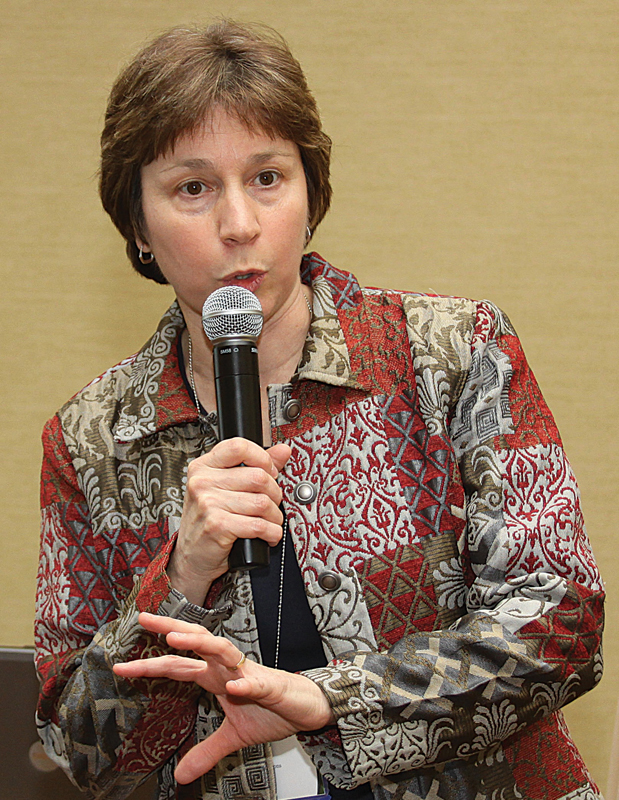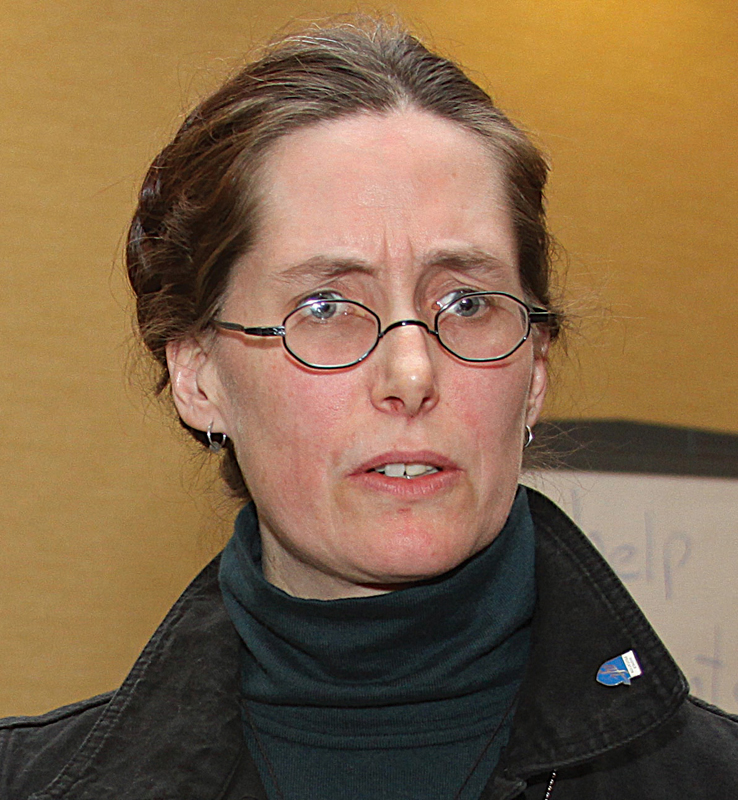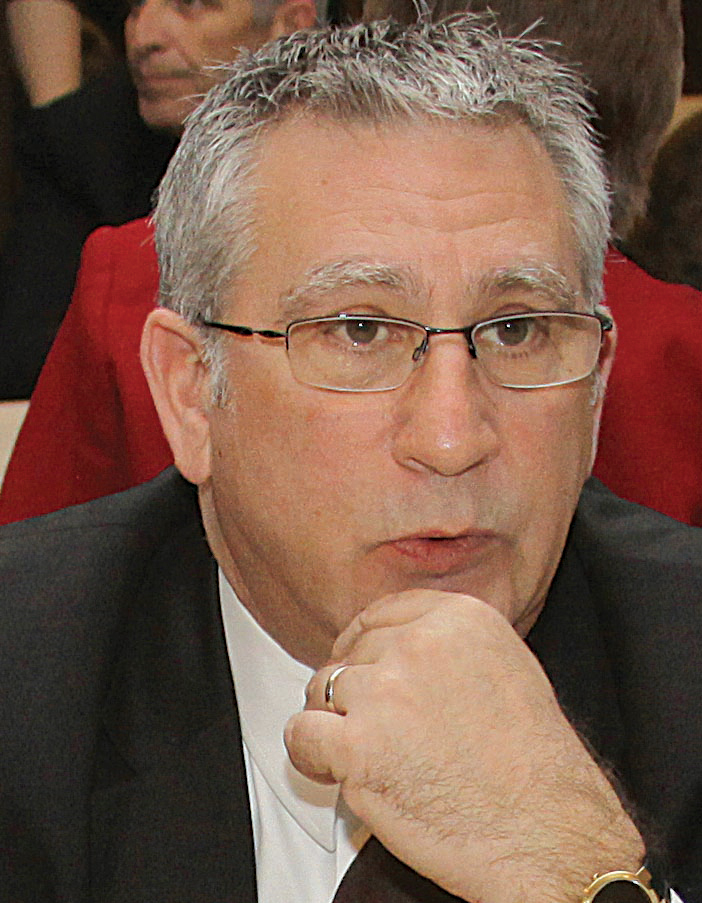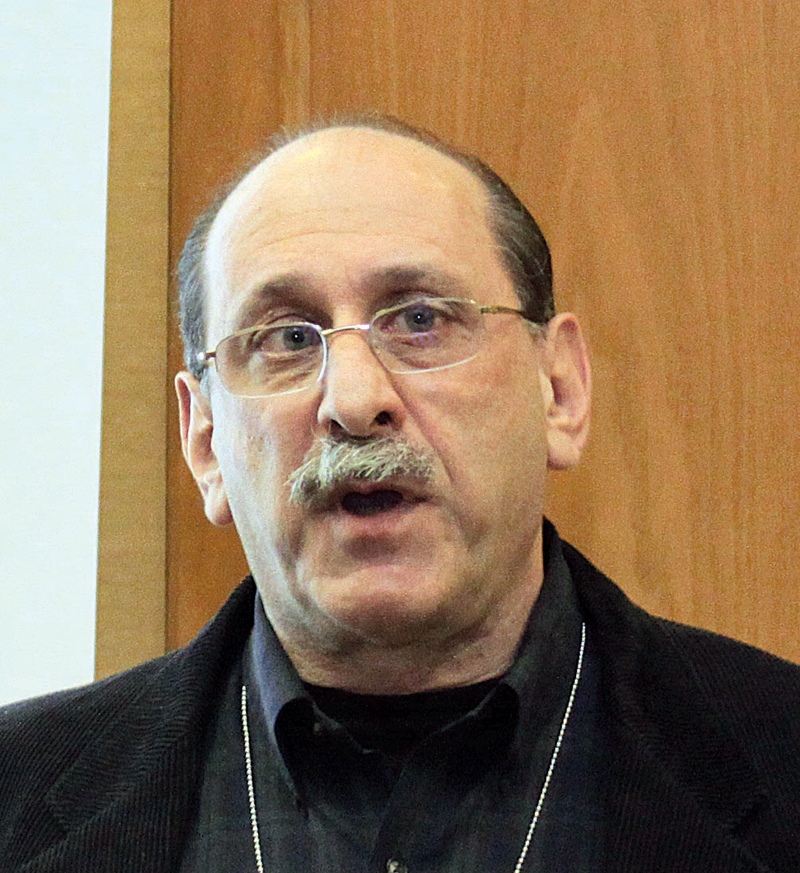|
The governor and state lawmakers reached agreement on a new state budget before the April 1 deadline, but the content of the 2011-12 budget was not exactly what UUP had hoped for. UUP refuses to throw in the towel. With the Legislature scheduled to be in session through June 20, the union looked to galvanize support among lawmakers to pass a supplemental state budget that includes funds restoring SUNY budget cuts. The governor’s proposed $100 million reduction for SUNY remained intact in the final state budget. That raised the total cut to SUNY’s operating aid to nearly $700 million during the past three years, meaning that state support for SUNY has been sliced by one-third. The outcome proved slightly more encouraging when it came to SUNY’s three teaching hospitals, which had faced the elimination of their state support in the governor’s budget. In the final budget, lawmakers restored $60 million of the $154 million cut aimed at the hospitals in the Executive Budget, and the hospitals will amortize—in other words, reschedule—pension payments for a current-year savings of $24 million. “This level of restoration of state support is nearly unprecedented,” UUP President Phil Smith said. “But we need to keep pressing for additional restorations to enable SUNY’s hospitals to continue providing vital health care services for thousands of uninsured and underinsured New Yorkers, as well as work to restore funding to our campuses.” UB 2020 ALTERNATIVE Proponents of UB 2020 fell short of their goal to have the controversial plan included in the budget, but the proposal was still lurking in early May when the governor presented a scaled-down version of UB 2020 called NYSUNY 2020. In contrast to the original UB 2020 plan that called for $5 billion in construction, NYSUNY 2020 would offer up to $35 million in capital funds to each of the four SUNY University Centers as “seed money.” UUP had actively sought to stop UB 2020, and Smith said UUP has serious reservations about portions of NYSUNY 2020. “This proposal could permit the four University Centers to impose differential tuition. That could deny access to tens of thousands of students from low-income households,” Smith said as details of the plan were still emerging. “Potentially, that increased tuition could be used to fund public/private partnerships. We don’t think it’s fair to force students to line the pockets of private businesses.” UB 2020 emerged as one of UUP’s major targets as union advocates headed back to Albany with a revised legislative agenda. SEEKING A REVERSAL OF FORTUNE UUP’s revised agenda also urges lawmakers to pass an amended budget to reverse the massive cuts to SUNY campuses and hospitals. UUPer Barry Trachtenberg of UAlbany presented a personal account of how deeply SUNY has been cut. “When I started in 2003, I was one of five faculty in Judaic studies. Now we’re down to one faculty member—me,” he said during a legislative visit. UUPers also pressed lawmakers to extend the millionaire’s tax to raise additional revenue that could be used to restore funds to SUNY. The union’s advocates planned on pursuing these issues during the NYSUT Committee of 100 Advocacy Day May 10. UNITED FOR HIGHER ED UUP activists also worked for restorations prior to the budget vote. In addition to making personal visits to legislators, UUPers joined nearly 2,000 of their sisters and brothers from NYSUT— UUP’s statewide affiliate—the Professional Staff Congress representing CUNY faculty, PEF and CSEA for “A Rally for Public Ed” outside the state Capitol. UUP President Smith was among more than a dozen speakers addressing the rally on a blustery, late winter’s day. All asked that funding for education be restored in the budget and an extension of the millionaire’s tax. Smith also worked in partnership with SUNY Student Assembly President Julie Gondar. The two co-wrote a letter to the editor of the Albany Times Union calling for adoption of a rational tuition plan for the state university. But Smith cautioned that any such tuition plan must be accompanied by an increase in the maximum Tuition Assistance Program grant. The budget fight is not over. UUPers are urged to send letters to lawmakers via the union’s website and its advocacy site at www.savesuny.org, asking them to restore funding for SUNY and its hospitals in the supplemental budget. — Donald Feldstein |
SUNY budget cuts hit home
|
The nearly $700 million in state budget cuts targeted at SUNY are taking their toll on thousands of working families. The family of UUP delegate Dawn Leadley of Upstate Medical University is among them. Fewer course offerings and class sections have frustrated Dawn’s daughter, Courtney, in her pursuit of a SUNY degree. The problems started when Courtney was a freshman looking to register for engineering courses at the University at Buffalo. “She couldn’t get into the lower engineering classes, because upper-class engineering students were filling them,” Dawn said. “She would get edged out because there weren’t enough faculty to teach the number of students they had.” Courtney ran into the same problem enrolling in required math courses, so after three years at UB, she gave up on the idea of an engineering degree. She transferred to SUNY Environmental Science and Forestry to pursue environ-mental biology, but ran into obstacles there, too. She was unable to register for a required field research course. “There were hundreds of people in the room trying to get into this class and it was filled in five minutes,” Dawn said. As a result, it will take Courtney five years to earn her bachelor’s degree, an extra expense that many New York families are bearing due to budget reductions. Sharon Sofranko, a NYSUT member who works in the Hunter Tannersville School District, had a similar experience with her daughter, Sara. Sara is due to graduate in May from SUNY Cortland, but getting there wasn’t easy. “Sara couldn’t get the classes she needed, so she ended up having to take summer and intersession courses, some of them online and at a community college,” her mother said. “Even though she started college with six credit hours, we still ended up paying for more than four years of college.” Sharon thinks the deep budget cuts that complicated her daughter’s college experience were not merely about the state’s financial deficit. “Because if it were,” Sharon said, “lawmakers would have extended the millionaire’s tax.” — Donald Feldstein
|
2011 Spring DA: ‘UUP Delegates set union’s course during policymaking convention
|
Delegates re-elected President Phil Smith, Secretary Eileen Landy and Membership Development Officer Ed Quinn, and sent all but one incumbent back to the Executive Board in union elections held during the 2011 Spring Delegate Assembly (DA). More than 325 delegates attended the two-day DA, held May 6-7 in Albany. They listened to Smith’s update on union issues, such as the newly proposed NYSUNY 2020 plan, and voted on a number of resolutions, including items regarding affirmative action, academic freedom, and the American Association of University Professors (AAUP). Unionists unanimously approved special orders honoring Potsdam’s Ed Alfonsin as UUP?Outstanding Retiree of the Year, and the late Stony Brook delegate Salvatore Lentini for his service to the union. Delegates also collected $1,314 in donations for Alabama tornado victims, dollars that were matched by UUP. ELECTING LEADERS Union elections were center stage at the DA, with multiple candidates vying for statewide offices and eight Executive Board seats. Smith, who faced challenges from Vice President for Academics Fred Floss and Buffalo Center delegate Paul Zarembka, received 171 votes, a majority. Floss got 128 votes, followed by Zarembka with 16 votes. After the elections, Smith thanked delegates for returning him as president, and urged UUPers to unite and move forward. “The voters have spoken; we are all one,” Smith said. “Let’s move on.” In the race for statewide secretary, Landy received 251 votes, while Morrisville delegate Raul Huerta got 61 votes. The tightest race was between Quinn and Alfred delegate Robert Rees for statewide membership development officer. Quinn won a majority by a single vote, 155-154. Empire State College delegate Jacqui Berger is the Executive Board’s sole new member, winning the board’s specialized colleges seat. She joins Edison Bond Jr. of Brooklyn HSC, Caroline Bailey of ESF, Bob Reganse and Mike Smiles of Farmingdale, Plattsburgh Chapter President Dave Curry, Potsdam Chapter President Laura Rhoads, and Brian Tappen of Upstate Medical University as Executive Board at-large seat winners. Executive Board positions carry two-year terms, set to begin June 1. SMITH SPEAKS During his president’s report, Smith urged UUPers to stand together to repel a growing anti-union sentiment that has spread across the country. “We need to be united; we cannot be divided,” he said. He also expressed serious reservations about the NYSUNY 2020 proposal, a scaled- back version of the controversial UB 2020 plan. Smith warned NYSUNY 2020 could allow the university centers to charge differential tuition, which could cut off SUNY access to thousands of students from low-income families. The plan may also permit the universities to use increased tuition to fund public/ private partnerships. Smith noted that this is the 15th version of a SUNY flexibility proposal; UUP has been instrumental in defeating the others. USE SUNY SURPLUS UUP will continue to press SUNY and SUNY schools to use budget surpluses to cover state budget shortfalls, derail retrenchments and nonrenewals, and hire new academics and professionals. SUNY’s $600 million surplus is expected to grow by $120 million annually, more than enough to cover $100 million in state aid cuts in the state’s 2012 budget, Smith said. “The chancellor and the SUNY Board of Trustees have the power,” he said. “They should do the right thing.” RESOLUTION WRAP Delegates referred a proposed constitutional amendment regarding UUP election procedures to the Executive Board, which will create a task force to investigate the issue. Delegates will hear a report on the matter at the 2011 Fall Delegate Assembly. They also approved an Affirmative Action Committee resolution that encourages chapters to appoint affirmative action officers and to consider a constitutional amendment at the 2011 Fall DA to reinforce the election or appointment of an affirmative action officer. The item requires UUP to implement a training program for chapter affirmative action officers, and to develop and publish an affirmative action handbook. Delegates also approved resolutions to: • Condemn the actions of governments in Bahrain, Egypt, Libya, Syria and Saudi Arabia for “excessively repressing” the voices of academics and university students and for persecuting faculty because of their religious affiliations. • Direct UUP’s president to investigate alleged bargaining unit interference involving AAUP. • Offer UUP’s support of Sodexo workers employed on SUNY campuses to ensure them rights to fair wages, benefits and union organizing activities. • Take action to use “all available means” to resolve attacks on the integrity and academic freedom of bargaining unit members teaching online courses. • Oppose a proposed change of U.S. Patent Law from a “First to Conceive” to “First to File” basis to protect UUPers who file patent applications when their work is completed. • Oppose a move by Harper Collins to change the basis of its e-book sales to libraries from outright purchase to a limited use license. • Encourage documents distributed to UUPers be printed using Tahoma 12 point font or in an enlargeable electronic format. • Invite Dr. Jesse Kabwila Kapasula to serve as a SUNY visiting professor until her safety can be reasonably assured. Kapasula, acting president of the Chancellor College Academic Staff Union, was fired by the government of Malawi over academic freedom issues and has received death threats. Highlights of the DA are posted on the UUP website at www.uupinfo.org. — Michael Lisi
Above left, UUP intern Mark Agnello helps Cobleskill delegate Z.J. Jiang send a letter to lawmakers urging them to reject the NYSUNY 2020 bill. Above right, Treasurer Rowena Blackman-Stroud discusses the consolidation of SUNY Downstate Medical Hospital and a private downstate medical facility.
|
Delegates adopt 2011-12 budget
|
Union delegates to the 2011 Spring DA in Albany unanimously adopted an annual operating budget of $8.55 million that reflects the union’s priorities for 2011- 2012: contract negotiations, service to the membership, outreach activities, and recruitment of new activists. “UUP every year obtains maximum input from members when preparing its operating budget, and the document goes through a rigorous review by the Finance Committee and the Executive Board,” said UUP Treasurer Rowena Blackman- Stroud. “This year’s budget is no different; it reflects extensive discussions and debate at the statewide and chapter levels.” In her report to delegates, Blackman-Stroud noted that UUP negotiated a total of more than $1.26 million in direct support from NYSUT, up by 4 percent from the previous year. “Additionally, UUP was fortunate in negotiating monies from NYSUT’s Solidarity Fund,” she said. UUP has also set aside more than $150,000 for contract negotiations with the state. The current contract expires July 1, 2011. “Since negotiations is UUP’s highest priority, it is understood that expenditures over and above the allocation will come from the reserve fund,” Blackman-Stroud said. In addition to chapter allocations, the spending plan includes more than $200,000 to support chapter development activities, such as organizing projects for part-time, academic and professional members. Blackman-Stroud thanked the union’s Finance Committee, Executive Board, Audit Committee, chapter presidents and treasurers, and the UUP Accounting Department for their guidance in developing this year’s budget. — Karen L. Mattison |
Chapters, members earn UUP journalism awards
|
Representatives from nine chapters and the union’s retiree contingent left the Spring Delegate Assembly a little heavier than when they arrived. But the extra weight was a burden they were willing to bear. Several UUPers were awarded wooden plaques and certificates for outstanding writing, editing, design and websites in the annual UUP?Journalism Contest. “Our chapter newsletters editors, contributors and webmasters do a superb job of keeping their colleagues informed,” said UUP?President Phil Smith. “We are proud of the work they do to help spread the message that UUP is the union that makes SUNY? work.” Judges in the competition are professional journalists and graphic designers. Their comments follow the winning entries. Receiving recognition were: • Albany Forum—Honorable Mention for Best Editorial/Column by Candy Merbler; and Honorable Mention, Best Website, webmaster Michael Knee. “The information is factual, accessible and useful.” • Buffalo Center: UUP?News—First Award, Best Layout/Use of Graphics; and Honorable Mention, Best Website, editor/webmaster Mike Behun. “Confrontational but light-hearted visual pun on the cover (Furlough YOU) gets your attention. … Capitalization, color and font size effectively convey a more direct and intense message.” • Cortland Cause—First Award for General Excellence, editor Karla Alwes; and Awards of Merit for Best Feature Story by Jen Drake and Teri Vigars, Best Editorial/ Column by Craig Little, Best Layout/Use of Graphics by Boodie McGinnis and Marc? Dearstyne; and Best Website by McGinnis. “Well-organized content, solid writing, concise layout combine to provide useful information in a vibrant way.” • Empire State—Honorable Mention, Best Website, webmaster Jacqui Berger. “Good information is provided in a logical, easy-to-navigate way.” • Farmingdale Unifier—First Award, Best Editorial/Column by Yolanda Pauze; Award of Merit, Best Website; and Honorable Mentions, General Excellence and Best Layout/Use of Graphics, editor/webmaster Margaret Porciello. “Clean design. … The sassy column conveys important information with wit and directness. … A good website with useful information.” • Oneonta Sentinel—First Awards, Best Feature Story by Jen-Ting Wang, and Best Website, webmasters John Chiang and Alex Jean-Charles; Award of Merit, General Excellence; and Honorable Mention, Best Layout/Use of Graphics, illustrator Fred Miller. “An insightful explanation on comparing teaching effectiveness, fully backed up by copious sources. …. A very good website with a professional look; a blueprint for all UUP?chapters to follow.” • Retirees, The Active Retiree—Honorable Mention, Best Editorial/Column by Judy? Wishnia of Stony Brook. “A clear-eyed look at the trend of demonizing government. … This column faces the elephant in the room and bemoans it.” • Stony Brook Insight—Award of Merit, General Excellence, editor Pam Wolfskill. “This is a well-written, interesting newsletter that benefits from a variety of voices on a variety of topics. … Well laid out, tasteful design.” • Stony Brook HSC Bridges—Honorable Mentions, General Excellence, editor Pam White, Best Feature Story by Steven Jonas, and Best Editorial/Column by Kathy Southerton. “A good mix of information, advice and events. … An interesting first-person account of 40 years as a UUP?member. … A good message about a relatively new but crucial topic in all work environments (workplace bullying).” • Upstate Medical Advisor—First Award, General Excellence, editor Dawn Leadley. “Best looking package in this year’s competition. … Very sophisticated name- plate and font choice. … Liberal use of photos, and a wide variety of topics and housekeeping information, too.” Judges were Sherry Halbrook, editor of the Public Employees Federation newsletter The Communicator; Mark Hempstead, illustrator and a former editor at the Albany Times Union; and Kevin Mattison, executive editor of The Recorder in Amsterdam. – Karen L. Mattison |
2011 NYSUT RA: ‘United We Lead’ UUPers join call to defend workers’ rights
|
In the wake of bitter attacks against unions and collective bargaining rights in a number of states, more than 100 UUP members joined more than 2,000 of their NYSUT sisters and brothers in vowing to fight back. The unionists brought together their collective strength during NYSUT’s 39th annual Representative Assembly, held April 7-9 in New York City. The RA’s theme, “United We Lead,” was a call for unionists to remain united to meet the serious challenges ahead of them. In his State of the Union address to delegates, NYSUT President Dick Iannuzzi detailed the obstacles facing public education and unions, and he warned that the struggle is not confined beyond the borders of New York. “Make no mistake about it, the battle isn’t only in the Midwest. The battle is here in New York as well,” Iannuzzi cautioned. “We see it in attacks on seniority and pensions. We see it in attacks on due process. And make no mistake about it, the battle will be fought here. And the battle will be won here.” SUPPORT FOR UUP UUP got help in its battle against SUNY budget cuts, in the form of a resolution sponsored by UUP passed unanimously by the delegates. The resolution called on NYSUT to work with the governor and the Legislature to ensure that SUNY and its hospitals receive adequate funding to carry out their core missions. Another UUP-sponsored resolution asked NYSUT to seek legislation requiring more transparency and accountability for the SUNY Research Foundation and other SUNY campus foundations. “If we could lift the veil of secrecy surrounding the Research Foundation, it could help us stop UB 2020 because the legislation would shed some light on the activities of the UB Foundation,” UUP President Phil Smith told the College and University Resolutions Committee. The resolution was adopted unanimously. UUP delegates also chose its representatives to the NYSUT Board of Directors. Rowena Blackman-Stroud, Tom Matthews and Ed Quinn were elected by the UUP delegation. UUP President Smith was re-elected by all RA delegates to an at-large board seat. MEETING CHALLENGES UUP members and their NYSUT colleagues applauded a series of speakers who lent their support to the political challenges the labor movement faces. AFT President Randi Weingarten said the tide is turning in favor of labor. “You see signs in store windows and letters to the editor,” she said. “People are saying the same thing; it’s wrong to take away rights, silence voices, crush the middle class and strip workers of their voice and dignity while giving huge tax breaks to the wealthy.” NEA President Dennis Van Roekel said the move to erode workers’ rights is not about economics. “It’s about silencing the voice of unions and the middle class,” he said. NYSUT Executive Vice President Andrew Pallotta fired up the crowd, asking members to not just be in the union, but be the union. “We have not yet begun to fight,” he shouted. “The revolution starts now, and it’s in our own backyard.” UUP delegates like Deb Zinser of Plattsburgh liked what they heard. “The attack on workers upsets me tremendously,” she said. “I’m livid that they feel as though they can take away benefits and bargaining rights of people who have worked hard to get to where they are.” UUPer Bruce Altschuler of Oswego agreed. “All of my colleagues work hard, and no one goes into academe for the money. We do it because we love our work,” Altschuler said. Wasting no time putting their words into action, RA delegates took up a collection to support the AFL-CIO’s Unity Fund. They raised nearly $15,000 and NYSUT added another $25,000 to the Unity Fund’s coffers. — Donald Feldstein |
On the street: How have the attacks on public employees affected you as a union member?
|
‘We Are One’ rally draws 15,000
|
Dozens of UUPers—including every statewide officer—joined nearly 15,000 of their union sisters and brothers at the “We Are One” rally in Times Square April 9. Many of the UUPers marched as a group for 15 blocks to the rally from the site of the just- concluded NYSUT RA shouting, “This is what democracy looks like.” Activists from across the state jammed the sidewalks along Seventh Avenue for more than four blocks south of Times Square for the rally—organized by the New York State AFL-CIO—prompted by the attacks on workers’ rights in a number of states. Those attacks include a new law in Ohio barring unionized public employees from negotiating health care, sick time or pension benefits. In Wisconsin, a new law strips public employees of their right to collectively bargain on anything except wages, and calls for almost all public workers to contribute more to their pensions and health care coverage, changes that amount to an average 8 percent pay cut. UUPer Janie Forrest-Glotzer of Oneonta found it very moving to be part of such a huge gathering to support and affect positive change for the labor movement. “It’s critical for unions to stick together and support one another under the ‘We Are One’ theme,” she said. “Together we support safe working conditions and health care for all.” A lineup of prominent labor leaders energized the crowd, leading them in chants such as “Workers united can never be defeated,” and “Respect our rights.” “We will not be pushed around,” said state AFL-CIO President Denis Hughes. “We will stand up and fight for the middle class. We are the labor movement and we are one.” “What we’re facing is an attack on working conditions,” NYSUT President Dick Iannuzzi said. “We hear this garbage about how it has to do with deficits, but it’s really an attack on collective bargaining.” AFT President Randi Weingarten and NEA President Dennis Van Roekel said unions will not go away in the face of demoralizing attacks. Rather, they have become stronger and more energized. Several speakers directed their attacks against the leaders of Wall Street and the wealthy who are using their clout to gain tax breaks while public workers are being targeted for sacrifices. UFT President Mike Mulgrew said history being made now will be a lesson for future generations. Mulgrew believes that 20 years from now, teachers will be telling the story of how the wealthiest 1 percent of the country tried to take more from the rest of us—and failed. The rally was part of a series of events held in the days around April 4 to honor the legacy of the Rev. Martin Luther King Jr., who was assassinated on that date in 1968 in Memphis. His assassination came one day after he gave a speech to striking sanitation workers who were demanding the right to bargain collectively. — Donald Feldstein
|
AFT Higher Ed Issues Conference: ‘Our work, our union, our students’
|
Union members are making a difference every day. UUPers?and more than 400 of their higher education colleagues from across the country know that only too well—and proved it once again in April during the AFT Higher Education Issues Conference in Philadelphia. Underscoring the theme “Making a Difference Every Day: Our Work, Our Union, Our Students,” participants discussed the growing concerns on college and university campuses nationwide, as well as the all-out assault on unions and workers’ rights. Six UUP members moderated discussions and served as panelists on issues ranging from the role of professionals in student success, to bullying on campus, to promoting faculty diversity. TAKING THE LEAD UUP?President Phil Smith moderated the opening plenary on confronting the fiscal and political crises across the nation. “We have an American public that has been fed a line that public employee pensions and other hard-fought union benefits are to blame for their problems,” Smith said. “America faces real economic and fiscal challenges. Our opponents—now in power—have chosen not to try to solve these problems, but to use their opportunity to destroy us where they can, and to exert as many concessions as possible where they can’t.” Smith set the stage for AFT?President Randi Weingarten, who called on unionists to take a stand for workers everywhere. “I don’t think anyone knew how evil these people are,”?Weingarten said. “These are not the faces of extremists, but of people who took the anxiety of the middle class and exploited it. They are trying to eviscerate every right, every economic benefit, every education initiative we’ve worked for all our lives. They want to change the body politic so, in Carl Rove’s words, they can have a ‘durable majority.’” Weingarten said the future of the labor movement is at stake, and urged members to mobilize. “Those of us in this room get to decide if we have the gumption to turn this moment into a movement,” she said. AFL-CIO Secretary-Treasurer Liz Shuler echoed that sentiment in her keynote address. “It’s important for us to remember that the protests spreading across America are not the result of the AFL-CIO, the Democratic Party or the Obama administration,” Shuler said. “This is a bottom-up, grassroots movement with its own momentum—a true spontaneous outcry against our winner-take-all political culture.” THE ISSUES The partnerships among labor unions and the community can—and should—be used to heighten public awareness of AFT’s higher education priorities and to show that education unions are not solely about their members, but about their work and their students, too. Key priorities of the AFT are academic staffing, student success, faculty diversity, and academic freedom—all of which were discussed at length during the three-day conference. Released during the conference was a new AFT report, “Student Success in Higher Education,” which offers the faculty and staff perspective on higher education curricula, teaching and student assessment. “We hope our perspective will advance the national dialogue on these concerns,” the report states. For the full report, go to www.aft.org and click on Higher Education. For further dialogue, go to AFT’s What Should Count website at www.whatshouldcount.org. UUPERS LEND A VOICE Panelists Jamie Dangler of Cortland and Charles Callahan III of Brockport discussed the growing gap between a diverse student population and the diversity of the faculty who teach them. The panel stressed the important role higher ed unions can play in improving the gender, racial and ethnic diversity of faculty with the goal of enhancing the educational experience of their students. UUP Vice President for Professionals John Marino moderated a workshop on the increased reliance on professionals to achieve student success. During the workshop, UUP delegate Jen Drake facilitated small-group discussions on strategies to ensure student success and on how the union can promote student values and support their needs. UUPer Joel Neuman of New Paltz, an associate professor of management and organizational behavior, shared his expertise on the hows and whys behind bullying. The panel also discussed how unions can institute policies to protect members from bullies. — Karen L. Mattison
|
‘We Are One’ Labor is under attack but fighting back
|
It started in Wisconsin. Gov. Scott Walker, a Republican with Tea Party ties and grand promises of fiscal responsibility, in February launched what’s become a nationwide political assault on unionism by forcing through a bill that strips public workers of almost all of their union rights. The law, passed by lawmakers and signed by Walker in March, restricts collective bargaining to wages, limits raises to inflation and forces 175,000 state workers to contribute more for pensions and health insurance. Walker said the “budget repair bill” was needed to help cover a $137 million budget shortfall. Badger State labor unions—rebuffed by Walker after offering to pay more for pensions and health insurance in trade for retaining union rights—didn’t see it that way. Instead, they came by the busloads, shouting their disapproval at daily rallies in the state Capitol. The protests attracted thousands of unionists from across America—including several UUP members—to Madison. Wisconsin’s blatant union-busting move sparked nationwide solidarity rallies, including several in New York attended by UUPers. UUP’s Geneseo Chapter organized a March 22 rally for labor on campus, and UUPers took part in rallies in Albany, Buffalo, Plattsburgh, and the massive “We Are One” event in Times Square April 9. Labor is under attack in almost half of the 25 states where public employees can collectively bargain; 12 other states restrict those rights to select public employees, like firefighters and teachers, and the rest bar the practice. Twenty-two states have so-called right-to-work laws, which make it illegal to require employees to join a union or pay dues. Senate Republicans joined the fray in May, introducing federal legislation to strengthen right-to-work laws by clarifying a state’s ability to enact them. The bill, which stemmed from a complaint filed against Boeing by the National Labor Relations Board, prompted South Carolina Sen. Lindsey Graham to criticize the Obama administration for being pro-union and anti-business, according to news reports. MIDWEST LABOR KNOCKS Ohio Republicans approved tough measures in March that limit public employees’ power to bargain for benefits, increase mandatory pension and health care contributions, eliminate automatic raises, ban strikes, and end automatic dues deductions from employee paychecks. In Michigan, the new emergency manager law, approved in March, allows the governor to appoint a manager who can break collective bargaining agreements in cities or school districts in a “financial emergency.” Bills to ban unions from paying members for time spent on union business and to levy hefty fines on striking unions are also being discussed. Illinois Republicans have floated two anti-union bills; one would prohibit public employees unions and union-affiliated political action committees from contributing to elections for statewide candidates. The other would make Illinois a right-to-work state. If that’s not enough, Illinois lawmakers want public employees to pay more for pensions and retirees to pay more for health insurance to help close a $4.2 billion budget gap. MORE LABOR WOES In Florida, anti-union proposals would decertify unions with less than 50 percent membership by July 1 and prohibit automatic payroll deductions for public employees’ union dues (see related story, page 17). The GOP-led Legislature passed a March bill to end tenure for new teachers, and to base job security and salary on student assessment test grades. In Massachusetts, the Democratic-led House of Representatives is behind a bill that would limit unions in bargaining for health insurance. And Tennessee’s Republican- led Senate voted in May to repeal collective bargaining for teachers, the only group in the state with those rights. The state’s House of Representatives has the bill in committee. That’s not all. More than a dozen other states, including New Hampshire, Pennsylvania and Indiana, have bills designed to impinge on union rights, ranging from right-to-work legislation to forcing unions to submit annual financial reports listing salaries, according to the National Conference of State Legislatures’ Collective Bargaining Legislative Database (http://bit.ly/iRkV9b). “Union-busting is more subtle than it was 100 years ago, but no less repugnant,” said UUP President Phil Smith. “The Pinkerton thugs of the early 20th century are gone, replaced by right-wing politicians on a mission to take down unions and send labor reeling into the past. But unionists have never stood still for this treatment and never will.” NOT GONNA TAKE IT Unions are fighting mad—and fighting back. In Wisconsin, intense pressure from unions resulted in an April restraining order that halted Walker from enacting his budget repair bill; the case won’t be argued until May 23 at the earliest. Wisconsin Democrats, with strong union backing, forced recall elections for six Republican senators. President Barack Obama came out against anti-union laws in Wisconsin and Ohio in a late April White House interview with a Cleveland television reporter. “Let’s certainly not blame public employees for a financial crisis that they had nothing to do with, and let’s not use this as an excuse to erode their bargaining rights,” he said. In Ohio, labor leaders have been collecting signatures to stage a referendum to repeal SB 5, Ohio’s anti-union law. Working with We Are Ohio, a coalition of union supporters formed to turn back the law, unionists were closing in on the 231,000 signatures needed for the referendum as The Voice went to press. In Florida, public employee unions relentlessly lobbied Senate Republicans, managing to persuade enough of them to derail—for the time being—a bill that would require unions to get members’ permission to spend dues money for political uses and to bar automatic payroll deduction to collect dues. Unions like United Faculty of Florida, which represents faculty at Florida’s state universities and colleges, have undertaken a systemwide recruitment drive to get chapters above the 50 percent membership threshold. Three UUPers traveled to Florida in April to help sign new members. Here’s how unionists in other embattled states are fighting back: • We Are One Illinois, a coalition of Illinois unions representing a million unionists, formed in May to protect public workers’ pensions from state cuts. The group has launched a $1 million multimedia ad campaign. • In Idaho, the 13,000-member Idaho Teachers Association sued Gov. C.L. “Butch” Otter in early May over the constitutionality of anti-union laws that end collective bargaining agreements for Idaho teachers June 30. • A political action committee called Reclaim Michigan is spearheading a recall election for GOP Gov. Rick Snyder. The union-supported group needs 1.1 million signatures by Aug. 5 to get the question on the November ballot. — Michael Lisi |


